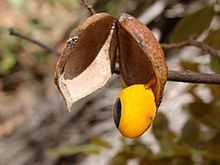Copaifera langsdorffii
| Diesel tree | |
|---|---|
| | |
| Copaifera langsdorfii in a park in São Paulo Brazil. | |
| Scientific classification | |
| Kingdom: | Plantae |
| (unranked): | Angiosperms |
| (unranked): | Eudicots |
| (unranked): | Rosids |
| Order: | Fabales |
| Family: | Fabaceae |
| Genus: | Copaifera |
| Species: | C. langsdorffii |
| Binomial name | |
| Copaifera langsdorffii Desf. | |

The tropical rainforest tree Copaifera langsdorffii is known as the diesel tree and kerosene tree. It has many names in local languages, including kupa'y, cabismo, and copaúva.
Biological description
It is a medium-sized tree usually reaching 12 meters in height, with white flowers and small, oily fruits. The wood is light due to its porosity. And, it is honeycombed with capillaries filled with oil. Tapping the tree involves cutting a well into which the oil seeps and where it can be easily collected. Despite its vigorous production of oil, the tree does not grow well outside of the tropics, and does not show promise as a reliable source of biodiesel in temperate climates.
Uses
Biodiesel use
It produces a large amount of terpene hydrocarbons in its wood and leaves. One tree can produce 30 to 53 liters of hydrocarbons per year, en masse producing 10,000 - 12,000 litres/hectare/year[1] which is incredibly high. The oil is collected by tree tapping. The main compound in the oil is copaiba, an oleoresin which is useful in the production of oil products such as lacquers and can be used as biodiesel. The tree is also the main source of copaene, another terpene.
Wood uses
The wood can be burned for firewood or used in carpentry.
Pollen collector
Bees utilize the tree for pollen collection.
Medicinal uses
The plant has a great number of historical medicinal uses.
References
- ↑ Qld farmers invest in diesel-producing trees, By Brigid Glanville, Mar 25, 2008, abc.net.au